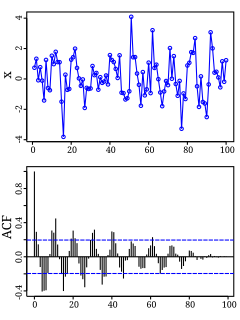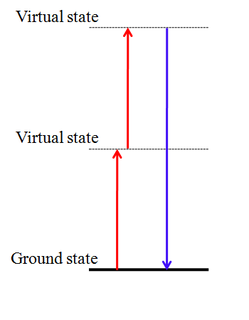
Autocorrelation, also known as serial correlation, is the correlation of a signal with a delayed copy of itself as a function of delay. Informally, it is the similarity between observations as a function of the time lag between them. The analysis of autocorrelation is a mathematical tool for finding repeating patterns, such as the presence of a periodic signal obscured by noise, or identifying the missing fundamental frequency in a signal implied by its harmonic frequencies. It is often used in signal processing for analyzing functions or series of values, such as time domain signals.

Nonlinear optics (NLO) is the branch of optics that describes the behaviour of light in nonlinear media, that is, media in which the polarization density P responds non-linearly to the electric field E of the light. The non-linearity is typically observed only at very high light intensities (values of atomic electric fields, typically 108 V/m) such as those provided by lasers. Above the Schwinger limit, the vacuum itself is expected to become nonlinear. In nonlinear optics, the superposition principle no longer holds.
Magnetic circular dichroism (MCD) is the differential absorption of left and right circularly polarized light, induced in a sample by a strong magnetic field oriented parallel to the direction of light propagation. MCD measurements can detect transitions which are too weak to be seen in conventional optical absorption spectra; they can also probe paramagnetic properties and the symmetry of the electronic levels of the studied systems, such as metal ion sites.
In physics, Wick rotation, named after Gian Carlo Wick, is a method of finding a solution to a mathematical problem in Minkowski space from a solution to a related problem in Euclidean space by means of a transformation that substitutes an imaginary-number variable for a real-number variable. This transformation is also used to find solutions to problems in quantum mechanics and other areas.
In physics, action is an attribute of the dynamics of a physical system from which the equations of motion of the system can be derived through the principle of stationary action. Action is a mathematical functional which takes the trajectory, also called path or history, of the system as its argument and has a real number as its result. Generally, the action takes different values for different paths. Action has the dimensions of [energy]⋅[time] or [momentum]⋅[length], and its SI unit is joule-second.
In theoretical physics and mathematical physics, analytical mechanics, or theoretical mechanics is a collection of closely related alternative formulations of classical mechanics. It was developed by many scientists and mathematicians during the 18th century and onward, after Newtonian mechanics. Since Newtonian mechanics considers vector quantities of motion, particularly accelerations, momenta, forces, of the constituents of the system, an alternative name for the mechanics governed by Newton's laws and Euler's laws is vectorial mechanics.
In control engineering, a state-space representation is a mathematical model of a physical system as a set of input, output and state variables related by first-order differential equations or difference equations. State variables are variables whose values evolve through time in a way that depends on the values they have at any given time and also depends on the externally imposed values of input variables. Output variables’ values depend on the values of the state variables.
In physics, circular motion is a movement of an object along the circumference of a circle or rotation along a circular path. It can be uniform, with constant angular rate of rotation and constant speed, or non-uniform with a changing rate of rotation. The rotation around a fixed axis of a three-dimensional body involves circular motion of its parts. The equations of motion describe the movement of the center of mass of a body.

A beam splitter is an optical device that splits a beam of light in two. It is a crucial part of many optical experimental and measurement systems, such as interferometers, also finding widespread application in fibre optic telecommunications.
In celestial mechanics the specific relative angular momentum plays a pivotal role in the analysis of the two-body problem. One can show that it is a constant vector for a given orbit under ideal conditions. This essentially proves Kepler's second law.

In optics, various autocorrelation functions can be experimentally realized. The field autocorrelation may be used to calculate the spectrum of a source of light, while the intensity autocorrelation and the interferometric autocorrelation are commonly used to estimate the duration of ultrashort pulses produced by modelocked lasers. The laser pulse duration cannot be easily measured by optoelectronic methods, since the response time of photodiodes and oscilloscopes are at best of the order of 200 femtoseconds, yet laser pulses can be made as short as a few femtoseconds.
In statistics, econometrics and signal processing, an autoregressive (AR) model is a representation of a type of random process; as such, it is used to describe certain time-varying processes in nature, economics, etc. The autoregressive model specifies that the output variable depends linearly on its own previous values and on a stochastic term ; thus the model is in the form of a stochastic difference equation. Together with the moving-average (MA) model, it is a special case and key component of the more general autoregressive–moving-average (ARMA) and autoregressive integrated moving average (ARIMA) models of time series, which have a more complicated stochastic structure; it is also a special case of the vector autoregressive model (VAR), which consists of a system of more than one interlocking stochastic difference equation in more than one evolving random variable.
Frequency-resolved optical gating (FROG) is a general method for measuring the spectral phase of ultrashort laser pulses, which range from subfemtosecond to about a nanosecond in length. Invented in 1991 by Rick Trebino and Daniel J. Kane, FROG was the first technique to solve this problem, which is difficult because, ordinarily, to measure an event in time, a shorter event is required with which to measure it. For example, to measure a soap bubble popping requires a strobe light with a shorter duration to freeze the action. Because ultrashort laser pulses are the shortest events ever created, before FROG, it was thought by many that their complete measurement in time was not possible. FROG, however, solved the problem by measuring an "auto-spectrogram" of the pulse, in which the pulse gates itself in a nonlinear-optical medium and the resulting gated piece of the pulse is then spectrally resolved as a function of the delay between the two pulses. Retrieval of the pulse from its FROG trace is accomplished by using a two-dimensional phase-retrieval algorithm.
Grating-eliminated no-nonsense observation of ultrafast incident laser light e-fields (GRENOUILLE) is an ultrashort pulse measurement technique based on frequency-resolved optical gating (FROG). The acronym was chosen because of the technique's relationship to FROG; grenouille is French for frog.
A vector-valued function, also referred to as a vector function, is a mathematical function of one or more variables whose range is a set of multidimensional vectors or infinite-dimensional vectors. The input of a vector-valued function could be a scalar or a vector ; the dimension of the domain is not defined by the dimension of the range.

Second-harmonic generation is a nonlinear optical process in which two photons with the same frequency interact with a nonlinear material, are "combined", and generate a new photon with twice the energy of the initial photons. It is a special case of sum-frequency generation.
Multiphoton intrapulse interference phase scan (MIIPS) is a method used in ultrashort laser technology that simultaneously measures, and compensates femtosecond laser pulses using an adaptive pulse shaper. When an ultrashort laser pulse reaches a duration of less than a few hundred femtosecond, it becomes critical to characterize its duration, its temporal intensity curve, or its electric field as a function of time. Classical photodetectors measuring the intensity of light are still too slow to allow for a direct measurement, even with the fastest photodiodes or streak cameras.
In classical mechanics, the central-force problem is to determine the motion of a particle under the influence of a single central force. A central force is a force that points from the particle directly towards a fixed point in space, the center, and whose magnitude only depends on the distance of the object to the center. In many important cases, the problem can be solved analytically, i.e., in terms of well-studied functions such as trigonometric functions.
In kinematics, the acceleration of a particle moving along a curve in space is the time derivative of its velocity. In most applications, the acceleration vector is expressed as the sum of its normal and tangential components, which are orthogonal to each other. Siacci’s theorem, formulated by the Italian mathematician Francesco Siacci (1839–1907), is the kinematical decomposition of the acceleration vector into its radial and tangential components. In general, the radial and tangential components are not orthogonal to each other. Siacci’s theorem is particularly useful in motions where the angular momentum is constant.
Hamiltonian optics and Lagrangian optics are two formulations of geometrical optics which share much of the mathematical formalism with Hamiltonian mechanics and Lagrangian mechanics.

















